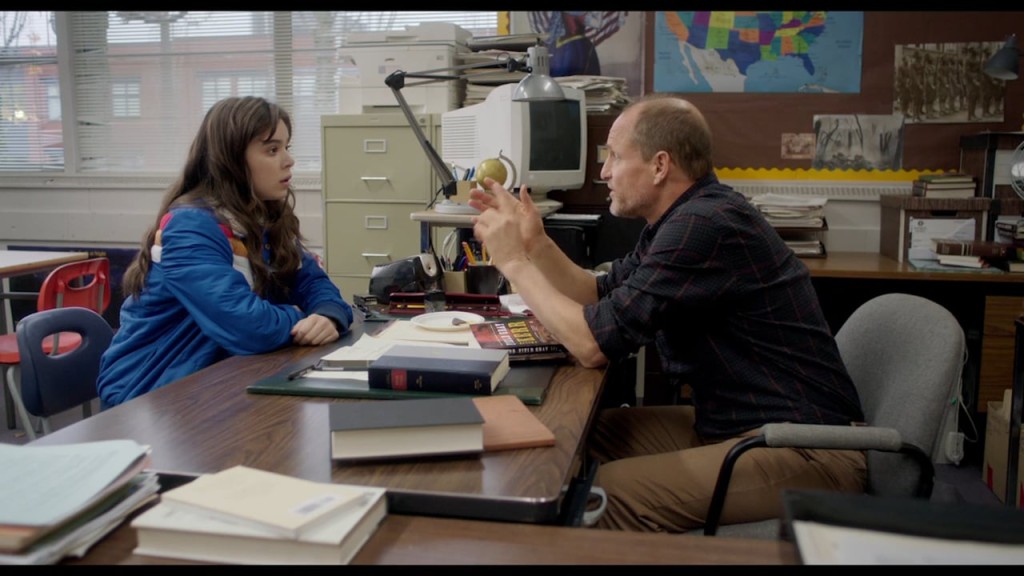
Millennials and admirers of both visually stunning cinematography and physically alluring actors were lovestruck by the enchanting trailer for “The Edge of Seventeen” that aired throughout social media outlets as well as movie theatres. The brief preview featured teenage romance unfolding through text messaging, familial drama entwined with a lusty affair and the overarching angst of a high school girl whose pretty face alone could draw viewers in.
However, the actual movie amounts to a shallow teen drama embellished with attractive main characters and surface-level plot points that aim more to render the viewer’s sympathy than to serve as turning points in the character’s development — both of which culminated into a disappointing coming-of-age flop that added no new angles to a viewer’s knowledge of the already highly adapted teenage-adolescent experience.
17-year-old high school outcast Nadine (Hailee Steinfeld) is your typical angst-ridden teen, who describes herself as shy, awkward and underachieving as she has always fallen under the shadow of her popular and academically successful older brother Darian (Blake Jenner).
However, this description of herself falls short when, at multiple parts throughout the movie, her actions demonstrate that she is in fact not very awkward or shy at all but simply perceives herself as being so, such as when she has the effortless courage to call up a male classmate named Erwin (Hayden Szeto), who obviously has a crush on her, to ask if he would like to go to the fair with her that very night.
With only an incohesive protagonist who has no discernible qualities at hand, it’s difficult for the audience to connect to the character, especially when the plot also becomes disjointed by a series of unrelated roadblocks in Nadine’s life. First she walks in on her brother lying in bed with her best friend Krista (Haley Lu Richardson), which leads to a heated friendship break up between the two, then later sends a text message to an intriguing older student named Nick (Alexander Calvert) whom she is infatuated with that leads to a risky situation and prompts her to threaten to commit suicide (which is not really a spoiler alert, as the movie un-chronologically opens with this point).
But besides that, first-time director Kelly Fremon Craig doesn’t do much to portray the importance of these events in Nadine’s life as the movie simply skips from one difficulty to another without having the protagonist attempt to solve any of them at all. For instance, in the beginning of the movie when Nadine is 13-years-old, her supportive father Tom (Eric Keenleyside) dies from a heart attack, causing Nadine to enter a depression that puts her on daily medication up to age 17. Back in the present when Nadine enters a fiery argument with her mother Mona (Kyra Sedgwick), which ends with her mom claiming “Your father would be so disappointed in how you turned out,” the apprehensive teenager reacts by stealing her mother’s car and sending a lewd text message to her upperclassman crush Nick.
Apart from leading to an overly brash and impulsive reaction on behalf of Nadine, her father is never mentioned again in the movie nor is the car-jacking situation brought up to repair the relationship between Nadine and her mom, making the entire quarrel seem to have taken place simply to propel the forlorn teenager into getting in contact with her secretly admired one.
Although the film lacks in the main character’s personal development, it shines in artistic direction, as the stunning screenplay and ensemble of, for the most part, agreeable actors captured the appeal of youthful grace. The whole movie is cast in an undertone of blue-ish grey, which emphasizes the bright colors of Nadine’s outfits. Although her fashion sense is described by her unlikely confidant Mr. Bruner (Woody Harrelson), her history teacher, as being odd and sloppy, the unorthodox clothing combinations she wears, which consist of bold puffy vests, black checkered skirts and high top sneakers, ultimately has a reverse effect on the screen, utilizing the admirable “pretty girl in ugly clothing” aesthetic. The soundtrack include a pleasant mix of folk-rock, indie-pop and 60s and 90s throwbacks, seizing the musical psyche of the millennial experience.
“The Edge of Seventeen” should have offered a new perspective to the teenage dilemma that generally involves insecurity, anxiety and repulsion but rather portrayed the problems that teenagers face as being the highlight of the experience as opposed to the journey one embarks in resolving them. 17-year-old Nadine, the supposed high school heroine, is ultimately conveyed as a havoc-wreaking creature who bounces from one conflict to another in a riotous nature, teaching young audience members to be sympathetic toward these difficulties rather than to learn from them. Even if Nadine were to find a happy ending at the conclusion of the film (which cannot be revealed whether or not she does due to spoiler alert discretion), in reality, it wouldn’t be long before a brand new problem would find its way into her life and place her right back at the edge of seventeen all over again.
Rating: 3.5/10 stars








